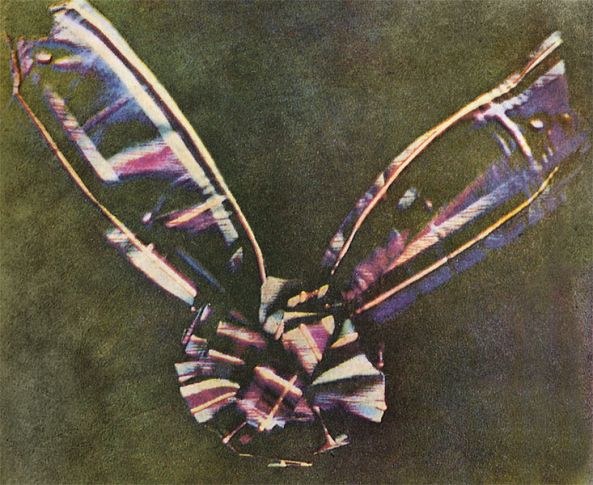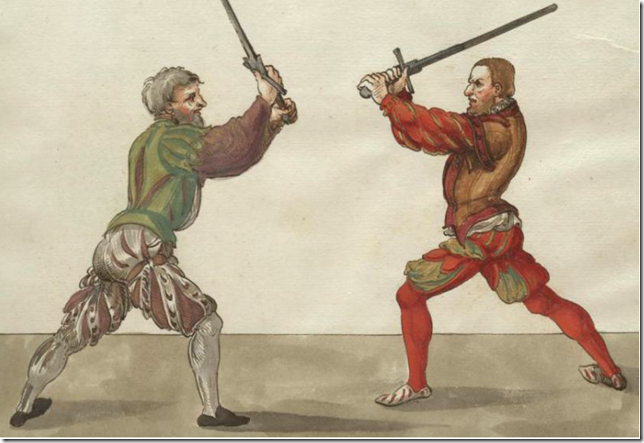Monthly Archives: November 2012
Day of Remembrance for Sigrith of Sweden
Meyer’s Longsword – Verfliegen or Flitting
Grauenwolf's Study of Western Martial Arts
Meyer writes,
This happens thus: in the Onset or the middle of the work, when you cut at your opponent’s opening, and he goes against you to catch your stroke in the air, then do not let his blade connect with your sword, but pull the stroke back in the air with a single motion to another opening. This work is very useful against an opponent who is only eager to chase your sword and not to harm your body.
Example
Starting in Zornhut, throw a Zwerch using the short edge along a flat arc. (Do not use the Zwerch that mutates from a Zornhauw.)
As your opponent goes to parry it, push strongly with the left hand while pulling with the right. This will cause the blade reverses direction and strike with the long edge along the line of G.
New Thoughts on the Translations of the Völuspá
Remembrance: Germany’s War Dead

While the 11th November 1918 was an end to the fighting for Great Britain and became the focal point for remembrance in the post-war world, it marked a day of defeat for Germany. It always seems fitting at this time of year that we should recall Germany’s losses as well as our own; the many Great War veterans I interviewed had much respect for ‘Fritz’ and knew that as front line soldiers, they all shared the same privations and conditions. By the end of the conflict Germany had suffered in excess of two million battlefield related deaths and this image from a German artilleryman’s scrap book gives us just one small insight into those huge losses, showing German graves on the Western Front in late 1917.
The German Army did not play an equivalent of the Last Post at the grave of a fallen comrades; instead they sang Ich Hatt…
View original post 93 more words
Two ways of throwing the Zwerch
Grauenwolf's Study of Western Martial Arts
It has occurred to me that there are two ways to throw a Zwerch from Zornhut. The first is a simple short edge cut that travels horizontally from start to finish.
The second option begins life as a Zornhau that transforms into Zwerch with a bit of a snap. When coming from vom Tag this is the action that I usually use.
I like the second version because…
- It delays the decision point
- It works from both guards
- I feel as though I have metal between me and my opponent’s blade sooner.
Research Topics
- Which version strikes faster?
- Which version strikes harder?
- Which version forms a defense sooner?
- Which version forms a stronger defense against each of the primary attacks?
The Battle of Moytura 1: Echtrae Nuadat – The Adventures of Nuada
Nuada Láim Argait, the merchant king with the Silver Arm, leads his people in wisdom and strategy for much of the saga of the Second Battle of Moytura. He is widely regarded as cognate with the British Celtic god Nodens. So when and how, mythologically speaking, did he come to Ireland?
This first episode of the second series of Acallam na nÉces takes in the opening sections of the text of Cath Maige Tuired, including the coming of the Dé Danann from the northern islands of the world. It also covers the first battle, the battle of Southern Moytura where Nuada lost his arm, and how Dían Cécht replaced it with the famous silver one.
Join the Story Archaeologists in Trench 1 of our biggest dig yet!
Don’t forget to subscribe to get the latest posts! Related Articles will be posted in the days to come…
Old episodes now…
View original post 14 more words
The Dogs of War — A Short History of Canines in Combat
A new monument commemorating the sacrifices of some very special warriors will be dedicated in California in the New Year. The memorial won’t honour soldiers, sailors, fliers or even the Coast Guard however. Instead it will pay tribute to the tens of thousands of dogs that have served the United States military since World War Two. According to a recent article in the Kansas newspaper The Wichita Eagle, the nine-foot tall bronze and granite statue will be officially dubbed the U.S. Military Working Dog Teams National Monument. Surprisingly, this isn’t the first memorial commemorating America’s ‘dogs of war’. Already markers to patriotic pooches adorn such places as March Air Force Base in Los Angeles; Bristol, Pennsylvania, the U.S. naval base on Guam and Fort Benning Georgia. The difference is that this latest tribute will be the first-ever national monument devoted to dogs.
Dogs at War – No New Trick
View original post 1,353 more words
Revisiting Meyer’s Ochs
Grauenwolf's Study of Western Martial Arts
Having seen that subtle differences can change the compass of cuts one can throw from a guard, it is time to look at Ochs again.


Notice how Meyer’s ochs doesn’t sit with the flat upwards. Rather, it has the long edge angled upwards. Using this variant I can throw any cut from A thru D from the right guard with what feels to me as a more fluid action. (Your results may vary.)
It also gives me the ability to catch the enemies blade with the edge rather than the flat. This has three advantages:
- The bade is wider edge-to-edge than flat-to-flat, which means it pushes his blade further away from my knuckles.
- It offers me the ability to trap the opponent’s blade between my strong and my quillon.
- If I had a shield (the part of the blade that looks like an inverted triangle) this would bring it into…
View original post 53 more words
Saxon heathenry encounters christianity first time
Saxon men which were mercenaries in the Roman army where they sometimes acquired high positions, have ondoubtedly passed on information to the people of their homeland. Especially when christianity got a monopolyposition at the end of the fourth century. Long sincethe first century the Germanic warriors served in the Roman army, which caused a great pull towards (young) men.
“It’s not unthinkable that almost every bigger settlement in the North-East past of the Netherlands during the Late-roman period had a son serving in the Roman army”
After the Roman Period the saxons also had contacts with the Frankish Empire, which had been christianized since the end of the sixth century – mainly thru the agency of the Irish monk Columbanus. In the Frankonian armies there also were Saxon mercenaries in service. In the south-west border regions of Old Saxony lived a mixed Saxon-Frankish population.
View original post 565 more words
First Colour Photograph

The first colour photo, an additive projected image of a tartan ribbon, was taken in 1861 by the Scottish physicist James Clerk Maxwell.
Revisiting Meyer’s Zornhut
Grauenwolf's Study of Western Martial Arts
One criteria for evaluating a guard is how many cuts one can throw from it. The more options the guard offers you, the harder it will be for your opponent to predict your next action.
Until recently my interpretation of the Zornhut had the point back and slightly to the left. This allowed me to throw cuts along the line of A thru D, which isn’t too bad. I can even occasionally throw an H, though it is a little clumsy.
Increasing the Compass
As I was writing up some lecture notes for an upcoming Meyer class, I was reminded that Meyer prefers to wrap the sword so far around himself that point is somewhat forward. Why?

Trying to match the plate, I discovered that it increases my range of cuts by nearly two letters. By pushing both hands above my head as I begin my step, I can reliably…
View original post 176 more words
Law codes of the Frisians and the Saxons

The Frisians got their Lex Frisionum -“the law of the Frisians” around the year 790 by matter of Karl the Great
The people of Old Saxony – The Saksen / Saxons didn’t get less then 3 lawbooks. In chronological order these are:
– the Capitulatio de partibus Saxionae (CPS) meaning: the lawbook concerning the Saksen
– the Capitulare Saxonicum (CS) – The Lawbook of the Saksen / Saxon people
– the Lex Saxonum (LS) – The Saxon lawbook
View original post 885 more words
Rule Britania – More than 80 percent of Planet Invaded by Brits Throughout History, Book Reveals
What do Burundi, Guatemala, Luxembourg and Uzbekistan all have in common? Simple: They are four of the small handful of countries in the world that have never directly experienced British military involvement.
According to a new book, entitled All the Countries We’ve Ever Invaded: And the Few We Never Got Round To by British author Stuart Laycock, Great Britain has used its military to coerce, dominate, assist or subjugate more than 82 percent of the countries in the world – no small feat for a tiny island nation that’s roughly half the size of the state of California.
Laycock told the British newspaper The Daily Telegraph last weekend that the idea for the book came to him when his son asked how many locations on the planet the United Kingdom had fought in.
“I was absolutely staggered when I reached the total. I like to think I have a relatively…
View original post 306 more words
Vampire burial discovered in England
Air New Zealand partnered with WETA Workshop on a brand new Hobbit inspired Safety Video..
Paulus Hector Mair – Prechfennster or the Speaking Window Guard
Grauenwolf's Study of Western Martial Arts
I’m not sure how the initial cut is supposed to work here, but it sure looks interesting.
It happens like this in the Prechfennster (Speaking Window): stand with your right foot forward and hold your hilt in front of your head such that your thumbs are underneath, the point is high on your right side, and you look out at the opponent between your arms (as in left side of illustration). Drop the sword down on your right side as you step in with your left foot and strike him powerfully to the head.
Volkstrauertag 18th of November – Germany remembers the dead
Another Krumphauw for Meyer
Grauenwolf's Study of Western Martial Arts
I was recently introduced to another version of the krumphauw that ends as shown in the plate D.
Pynenberg’s version gets us into that position while performing a long edge strike. This version also uses a long edge strike, but the wrist rotates instead of blade.
Say the RED edge is long and the BLUE edge is short, and the RED edge krumps the opponent’s blade. If you rotate the right hand around the grip so that the knuckles are facing upwards then the left wrist naturally moves under the right.
Looking at the final position, the BLUE edge has become long and the RED short for the purpose of the next cut.
Thus far I have seen no other example of this reversing of long and short edges. But with a symmetrical weapon, there is no reason why it couldn’t occur.
More importantly, it is an easier action to…
View original post 15 more words


